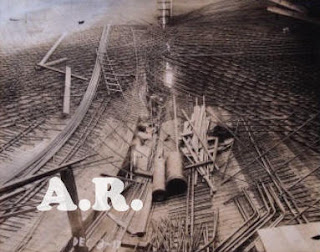Fotógrafo Service Studio Photo. Fotografía antigua construcción del barco S.S. Faith.
 El tema de esta fotografía sería difícil de adivinar pero, aun así, todos vemos que es una bonita fotografía.
El tema de esta fotografía sería difícil de adivinar pero, aun así, todos vemos que es una bonita fotografía.
El tema favorece la actuacion del fotógrafo que crea una imagen extraña, desconocida pero que atrae.
Estamos ante el entramado necesario para la construcción de un barco de hormigon armado.
Efectivamente, suena raro a nuestros oídos, pero estos barcos navegan y, durante un tiempo, se pensó que tendrian mucho futuro dado que eran baratos de construir, luego se vió que no eran operativos.
El barco es el S.S.Faith y se construyó en unos astilleros de Oakland California gracias al empuje del Leslie Comyn que creó la San Francisco Shipbuilding Company a tal efecto.
La fotografía fue realizada por Service Studio Photo (Market Street 123).
Links
Links
- Leslie Comyn Wikipedia
- Concrete ship Wikipedia
- S.S. Faith Wikipedia
- Ver album completo de la construcción
- William Leslie Comyn - San Francisco Shipbuilding company - S.S. FaithWilliam L. Comyn was an important business man, shipowner of the first concrete ship.
During World War I, he tried to convince several shipping companies to built this kind of ships, but he didn't succeed.
As a result, he created the San Francisco Shipbuilding Company -1917- in Oakland California.
In January 1918, he began to built the first concrete ship, named Faith, and designed by Alan Macdonald and Victor Poss.
SS Faith was able to pull 8000 tons, so it was the biggest ship of its time in the world when launched.
The first journeys headed to Honolulu, Balboa, Callao, Valparaíso y Nueva York.
In 1919 Comyn sold his company to French American SS Lines.
After the World War I, 12 concrete ships were build and used for commerce as soon as the World War ended.
In 1921, the SS Faith ended his life as a breakwater in Cuba.
Nowadays these ships are not constructed any longer, they are part of the history of Navigation as cheaper boats became more popular.
Size:
-
97,54 x 13,56 x 6,86 m
-
2 triple expansion steam machines. 1700 hp. 10 knots.
See also
-
Leslie Comyn - http://en.wikipedia.org/wiki/William_Leslie_Comyn
-
Web about concrete ship - http://www.concreteships.org/history/
-
New York Times news about its launching - http://query.nytimes.com/gst/abstract.html?res=9F03E3DF103BEE3ABC4D52DFB5668383609EDE
-
More articles about the SS Faith in the New York Times
-
History of concrete ships
-
Information of the San Francisco Shipping Company - http://www.mareud.com/Ferro-Concrete/san_francisco_shipbuilding_company.html
- This album consists of more than 100
vintage photographies mounted on a black cardboard. These high
quality photos have the date on it, showing the chronologie of the
construction of the concrete ship.
When bought, the album had an envelope with this sentece: "Nicolson/launching of the Faith March 14, 1918". The seller indicated (and I couldn't check the information yet), Nicolson was an engineer of the San Francisco Shipbuilding Company and his image is in some of the photos.
Pasted on the front cover, there were two pieces of a newspaper:
-
One with an image and the following text:
Carrying a General Cargo the concrete ship Faith. Passing through Gaillard Cut Panama Canal en route from New York to Valparaiso on the Stone Hull has been conclusively demonstrated by this vessel, which has Weathered heavy storms an travelled thousands of miles during the past year.
-
Another text without image:
N.Y. Gets sugar in Concrete ship Faith
By associated press
New York Nov. 21.
The American steamship Faith, the largest concrete ship in the world, launched March 14 last on the Pacific Coast as an experiment in this metod of construction, arrived here today with a cargo of sugar from Cuba
-
On the back cover, there was another label:
The ideal
To duplicate order
Nº 7633 B
Made by
The J.L. Hanson Co.
Chicago
Concrete Shipbuilding in San Diego, 1918-1920
Chronology
1849 Concrete skiff made in France. 1859 Concrete barges launched in Netherlands for canal use. 1909 Freighter barge put in service from Frankfort-am-Main. 7 Sep 1916 Congress creates U. S. Shipping Board. Feb 1917 Staff assembled for concrete ship design. 20 Apr 1917 USSB contracts for first concrete ship. 2 Aug 1917 Namsenfjord, first sea-going freighter, launched. 1 Jan 1918 Concrete Ship Section established. 18 Mar 1918 Faith launched. "Faith" left San Francisco 22 May on her first voyage commercial with a cargo of rock salt and copper ore assigned to Seattle. She traded in the eastern Pacific, Caribbean, and North Atlantic until December 1921.15 While not a standard prototype Faith nonetheless set parameters used to delineate 'stone' ships that followed. She was built on longitudinal framing joining transverse frames set 16 feet apart. Lugged bars woven in a diagonal mesh were encased in concrete, the skin being part of the framing. Her bottom was 4 1/2" thick, sides 4", and shelter decks 3 to 3 1/2". There were 7 watertight bulkheads. Her principal measurements were 320 x 44.5 x 27.7. Bethlehem Shipbuilding Company of Alameda provided a 1750 hp triple expansion engine that was 24" x 39" x 65" and 42". Gross tonnage was 3,427 and net 2,071; displacement was 4,500 tons.34